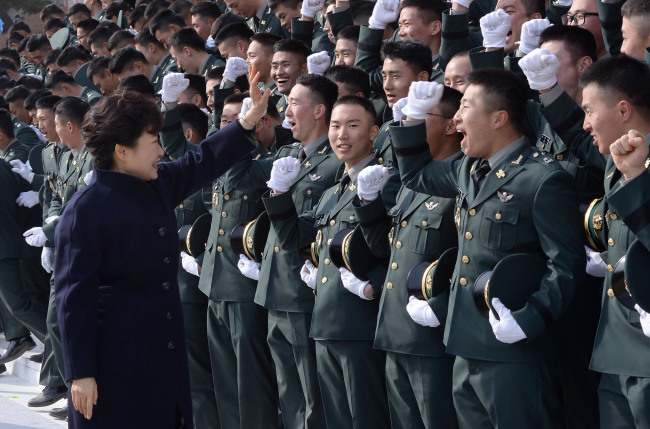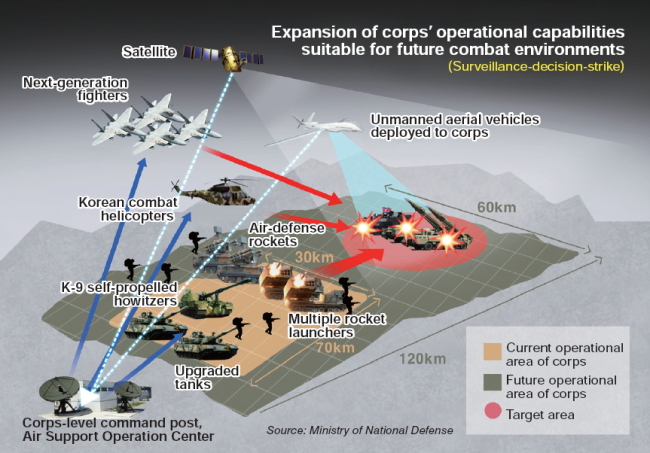Frontline corps to get greater command role
Korea to cut Army, adopt ‘proactive deterrence’
By Korea HeraldPublished : March 6, 2014 - 21:16
South Korea plans to reorganize frontline corps-level units into central players of its military operations in five years, a change designed to streamline the current field army-centered structure to ensure more flexible, nimbler operations.
It will also adopt a “proactive deterrence” strategy to allow for preemptive responses to signs of an all-out war and curtail its troop level to 522,000 by 2022 from the current 633,000.
Seoul’s Defense Ministry on Thursday unveiled these and other plans for its basic defense reform for 2014-30. It has revised or complemented its reform plans every 2 1/2 years since 2005 under the defense reform act.
It will also adopt a “proactive deterrence” strategy to allow for preemptive responses to signs of an all-out war and curtail its troop level to 522,000 by 2022 from the current 633,000.
Seoul’s Defense Ministry on Thursday unveiled these and other plans for its basic defense reform for 2014-30. It has revised or complemented its reform plans every 2 1/2 years since 2005 under the defense reform act.

President Park Geun-hye has endorsed the plans, the ministry said.
“The defense reform this time focuses on securing capabilities to prepare against low-intensity provocations as well as an all-out war,” the ministry said in a statement. “For the longer term, the plans aim to prepare for reunification and strengthen defense capabilities to counter potential threats.”
Under the reform package, the 1st and 3rd Armies will be merged to create the ground operations command, a move that would reduce the number of four-star generals to seven from the current eight.
The ground operations command will lead frontline units, which will become the centerpiece of the country’s field operations.

To allow those units to conduct more independent, comprehensive operations, the ministry will assign a set of subordinate units including those for air defense and logistical support to the corps.
The Air Support Operation Center will also be attached to the units to enable their commanders to easily mobilize aerial firepower during ground combat operations.
On the back of these organizational reinforcements and advanced high-tech military equipment, the operational areas covered by the corps will more than triple.
The realignment of all military installations will be completed by 2026, four years earlier than originally planned, officials said. Under the realignment plans, the military seeks to cut the number of corps to six from the current eight, the number of divisions to 31 from 42, and the figure for mechanized infantry brigades to 16 from 23.
As to the troop drawdown that will shrink the current troop numbers by more than 110,000, officials said that they had sought to set the possible troop number in consideration of the country’s demographic changes caused by the low birthrate.
Under the plan, the Army troop number will be reduced from 498,000 to 387,000, while the numbers of Navy, Air Force and Marine troops will remain unchanged at 41,000, 65,000 and 29,000, respectively.
To maintain combat capabilities amid the troop drawdown, the ministry plans to increase the proportion of more experienced senior-level officers to 42.5 percent from the current 29.5 percent, while slashing the number of enlisted troops to 300,000 from the current 446,000.
Observers pointed out that the reform plan could negatively influence naval operations, given that the Navy will have more operational assets to run with the same manpower, including three additional Aegis-equipped destroyers.
Another notable change in the reform package is Seoul’s adoption of a proactive deterrence strategy.
Previously, the military held an “active” deterrence strategy, which was designed only for cases of low-intensity provocations. The strategy has been criticized for being “too passive” in the face of an increasingly provocative Pyongyang.
The proactive strategy entails “preemptive measures,” which include all military and nonmilitary procedures to be taken in light of self-defense when there are signs of an imminent all-out war.
By Song Sang-ho (sshluck@heraldcorp.com)
-
Articles by Korea Herald






![[From the Scene] Monks, Buddhists hail return of remains of Buddhas](http://res.heraldm.com/phpwas/restmb_idxmake.php?idx=644&simg=/content/image/2024/04/19/20240419050617_0.jpg&u=20240419175937)








![[From the Scene] Monks, Buddhists hail return of remains of Buddhas](http://res.heraldm.com/phpwas/restmb_idxmake.php?idx=652&simg=/content/image/2024/04/19/20240419050617_0.jpg&u=20240419175937)

![[KH Explains] Hyundai's full hybrid edge to pay off amid slow transition to pure EVs](http://res.heraldm.com/phpwas/restmb_idxmake.php?idx=652&simg=/content/image/2024/04/18/20240418050645_0.jpg&u=20240419100350)

![[Today’s K-pop] Illit drops debut single remix](http://res.heraldm.com/phpwas/restmb_idxmake.php?idx=642&simg=/content/image/2024/04/19/20240419050612_0.jpg&u=)